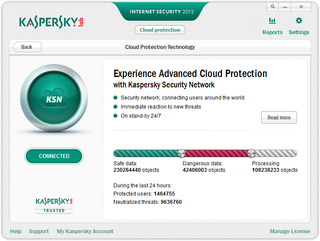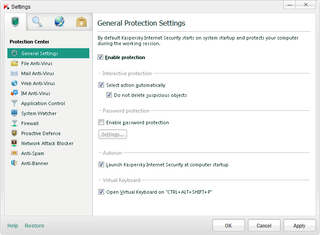Hybrid Protection from Kaspersky
Understanding Hybrid Protection
As mentioned, the Cloud Protection in Kaspersky Lab products provides a direct connection to their Urgent Detection System (UDS), which contains real-time characteristics of new malware or malicious websites. This is updated in part by the Kaspersky Security Network, which is made up by analyzing threat information from millions of other participating Kaspersky users. Kaspersky Lab products check the UDS database constantly, such as when you open a file or click on a link. If the program or website has the same characteristics of any threats in the UDS, they would be immediately blocked.

Cloud protection alone, however, isn’t enough to keep computers adequately protected. A combination of cloud-based and traditional protection is ideal and provides the greatest protection. This is what Kaspersky Lab’s deploys in their products, which they call Hybrid Protection. They consult real-time virus and threat information online in addition to using the traditional antivirus updates downloaded to your computer.
Here are a couple of security features that benefit the most from the Hybrid strategy:
· Anti-Malware: It can better detect and catch malware—whether it’s a virus, worm, Trojan, root-kit, or spyware—since the cloud protection provides real-time information on the newest threats.
· Anti-Phishing: It provides protection against the latest phishing schemes that try to steal your personal information.
· Program Reputation: It can provide a real-time report on the reputation of programs based upon expertise from security professionals and feedback from other users.
· URL Reputation: Websites and links are analyzed more quickly, keeping you from browsing to the latest dangerous sites.
· Anti-Spam: It provides enhanced spam detection to catch the newest junk mail from filling your inbox.
With Hybrid Protection, you aren’t limited in the settings and features you can access like with other cloud-only solutions. Kaspersky, for example, provides all the usual settings to customize protection and lets users perform scans and other functions at will.

At the same time, the cloud protection is transparent to the user. No additional settings or tasks are required. Cloud protection simply just works when you’re connected to the Internet and automatically stays in sync with the Kaspersky servers.
Current page: Understanding Hybrid Protection
Prev Page Why Choose Kaspersky for Your Internet Security Next Page Protecting Against the Primary Internet ThreatsStay on the Cutting Edge
Join the experts who read Tom's Hardware for the inside track on enthusiast PC tech news — and have for over 25 years. We'll send breaking news and in-depth reviews of CPUs, GPUs, AI, maker hardware and more straight to your inbox.